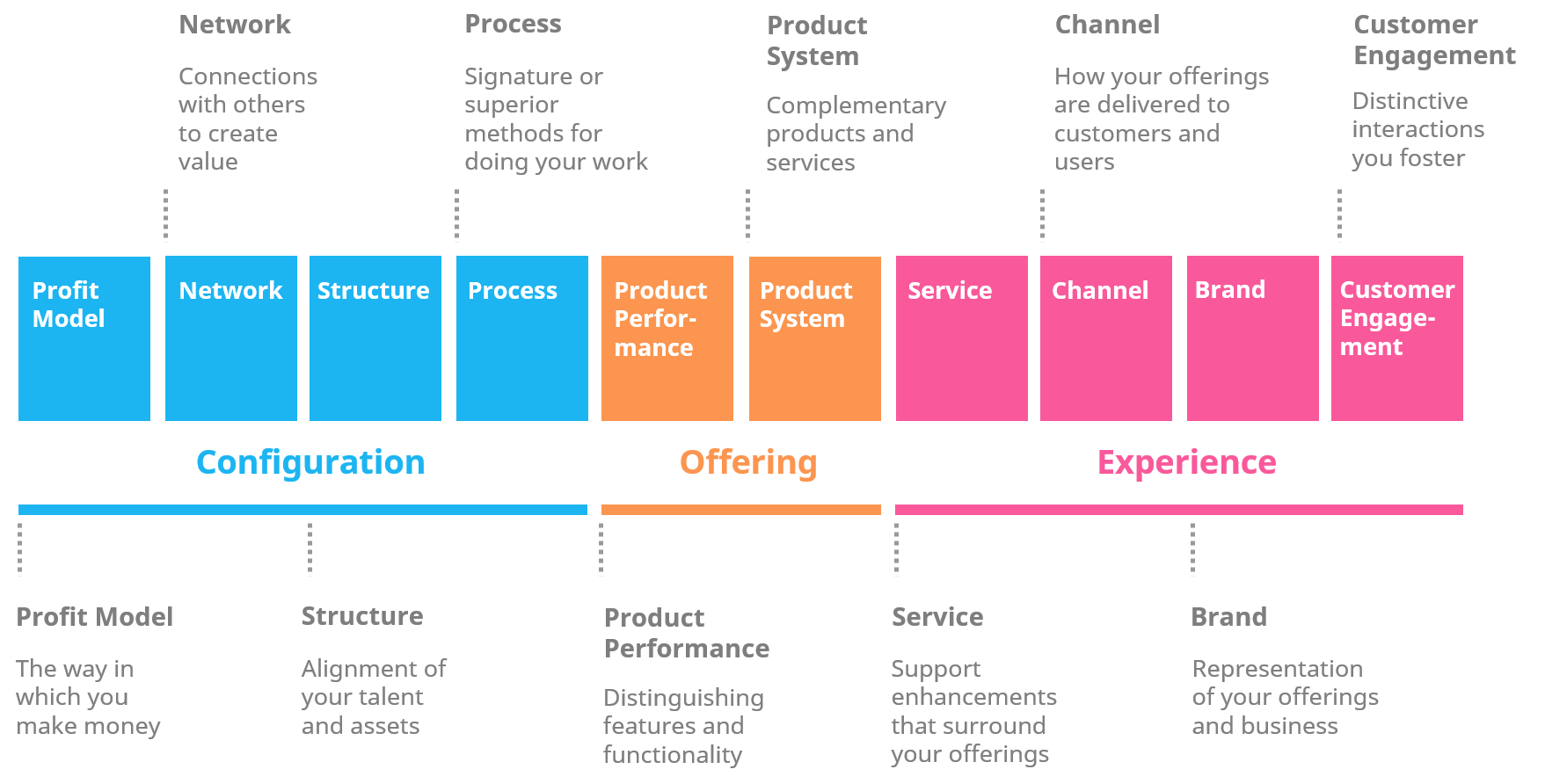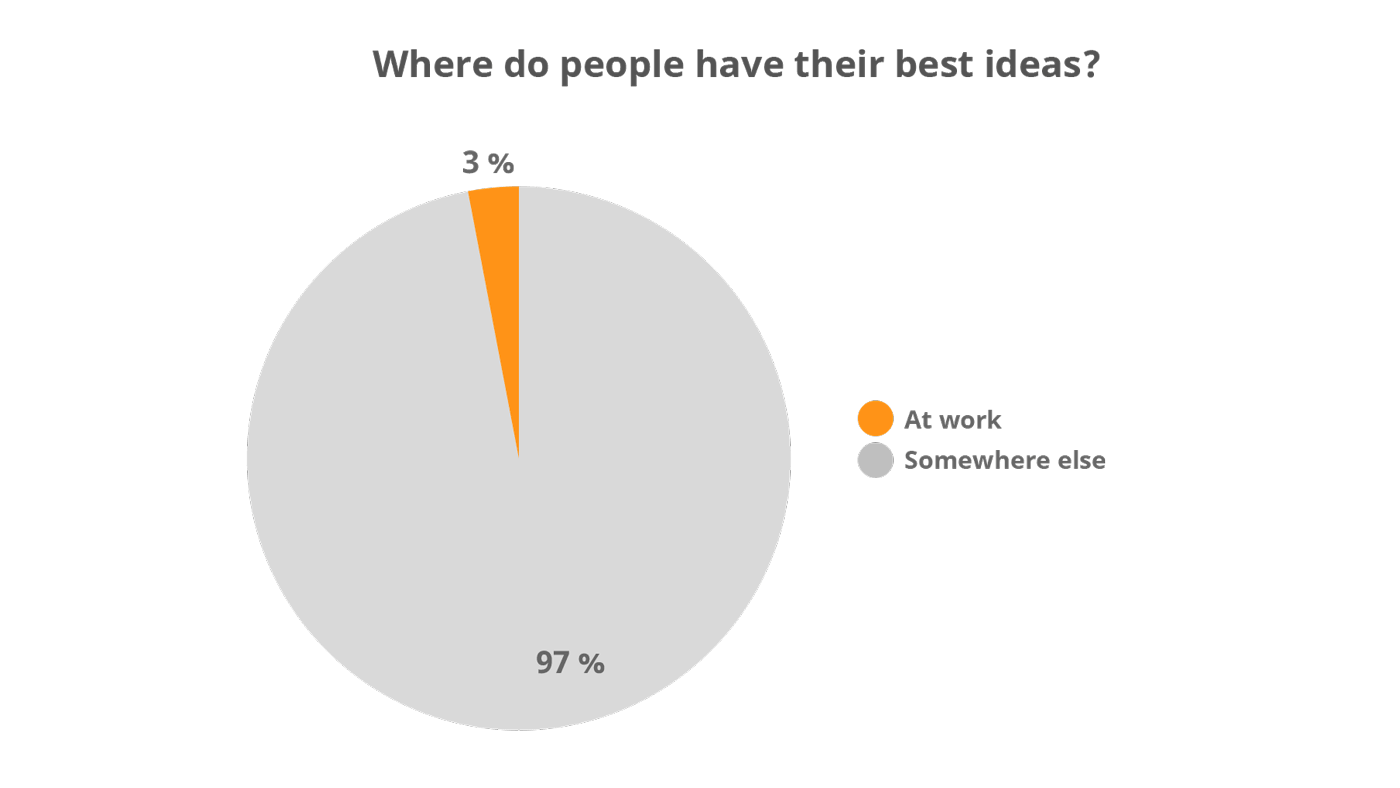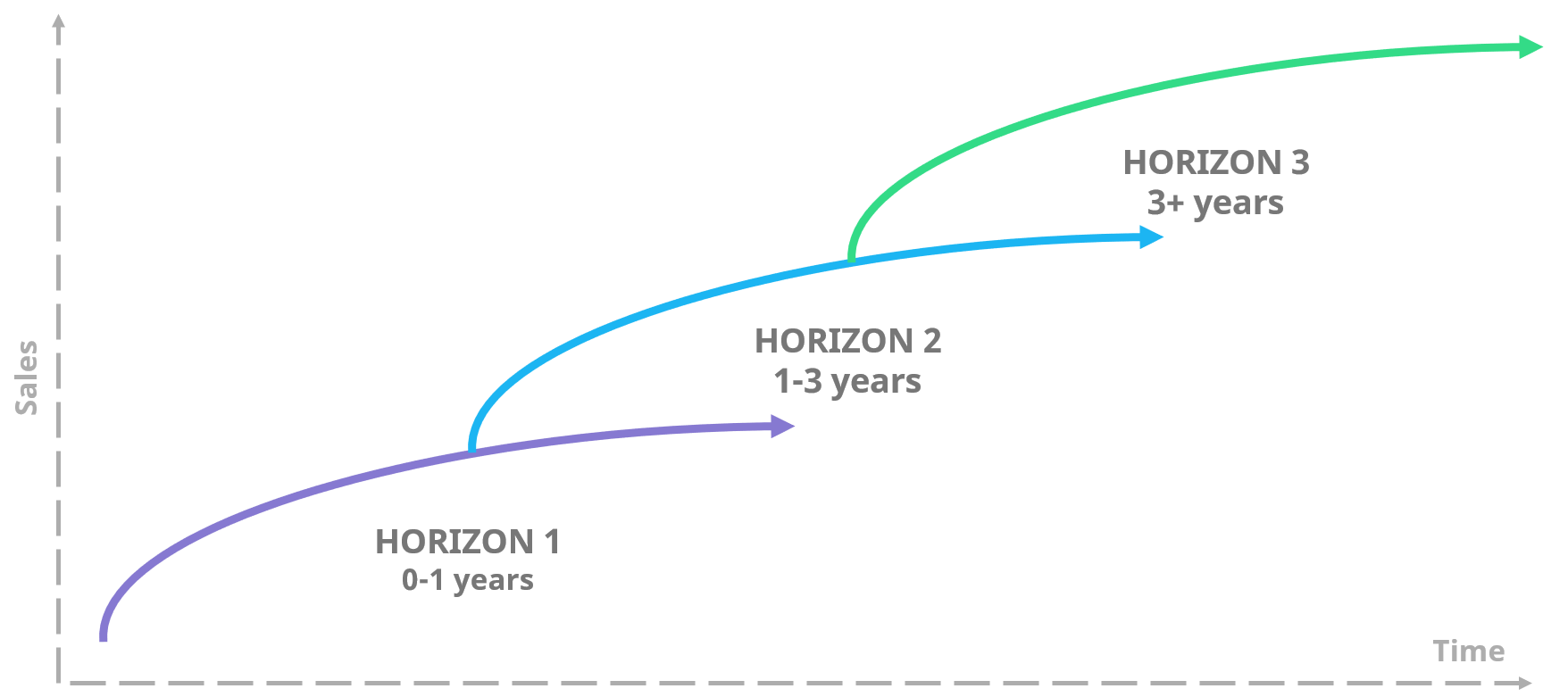21 Common Innovation Myths & Misconceptions Debunked
As all of us working on innovation know, it’s quite an opaque topic that many innovators and organizations don’t talk about openly. As a result, innovation is an area that’s fraught with many common myths and misconceptions.
That’s unfortunate, because those less experienced in innovation often end up going about it all wrong, and as a result, we as customers, and as a society, get less bang for our buck – and have to deal with challenges that could’ve already been solved.
At Viima, we’re working hard to democratize innovation, and today’s post is a natural way for us to further that mission. We’ll be covering 21 common myths and misconceptions about innovation that we often come across in our discussions with people in the field, some more common than others.
Myths are intriguing, because there’s usually a very logical reason for their birth, and if you are able to really understand that rationale, it unlocks a much deeper understanding of the topic itself.
So, in this post, we’ll talk about where they come from, what the actual reality is, and point you to resources where you can learn more about the topics behind them. This will be quite a long one, so if you're just looking for a quick summary, you may want to check this infographic first.
But, without further ado, let’s get to these myths and misconceptions on innovation.
Table of contents
- 1. It can’t be learnt
- 2. They are breakthroughs
- 3. Only geniuses can do it
- 4. It's a solo activity
- 5. It happens top-down
- 6. You can’t manage it
- 7. It's always positive
- 8. It isn’t for everyone
- 9. It should be centralized
- 10. It's done by engineers
- 11. Ideas come from workshops
- 12. It must be compensated
- 13. It's pointless to try
- 14. Large orgs are too big and slow
- 15. It requires big bets
- 16. Target the biggest markets
- 17. Customers will tell us how
- 18. It's about improved performance
- 19. It's fun
- 20. It takes years to see ROI
- 21. A tool can do it for us
- Conclusion
1. Innovation can’t be taught or learnt
The Myth
Innovation is, of course, difficult, and it usually feels a bit overwhelming when you’re first getting started with it, or even just starting to work on a new innovation project. So, when you see someone who’s great at it, and seemingly effortlessly keeps coming up with brilliant out of the box ideas, it’s easy and natural to attribute that virtuosity to them just being born with it.
When you combine that with the fact that there isn’t really a foolproof recipe or process you can use to succeed at innovation every time, even though there are good practices that can be very helpful, it does make sense that people think this way. We hear, all too often, innovation being talked about as a kind of a mysterious art that can’t be taught or learnt. You just have it, or you don’t.
The Reality
While some people certainly have more natural tendencies towards innovation than others, and it’s true that there isn’t a foolproof recipe for success in innovation, that doesn’t mean you couldn’t learn it.
Innovation is part science and part art. This combination of logical thinking, problem solving, creativity, empathy, and practical skills is difficult for most people. Many are great at some of the aforementioned, but very few at all of them naturally. However, that doesn’t mean that you couldn’t teach them, or learn to get better at each of these areas.
Many are great at some of the skills needed for innovation, but very few at all of them naturally. However, that doesn’t mean that you couldn’t teach them, or learn to get better at each of these areas.
The first step in learning innovation is to understand the key principles for how innovation works. For that, our blog and our online course The Innovation System are great resources.
Once you have that covered, it’s simply a matter of figuring out what the areas are that you’re lacking in, and then putting in the practice of trying to make innovation happen, as well as working on those individual skills needed for achieving that – or in the context of a team, finding others to complement your skills. But more on that later.
2. Innovations are these big breakthrough inventions
The Myth
Probably one of the most common myths and misconceptions we come across is that people think that if something isn’t a big technological breakthrough or a patentable invention, it isn’t “real innovation”.
That is understandable, given how we have countless definitions for the term, and how the media often uses it in misleading ways. Generally speaking, innovation is typically used to refer to just big technological breakthroughs.
In addition, many large organizations have a long history of being super R&D focused with their innovation work, which has led to innovations and patents being virtually synonymous. Again, this is very understandable given how historically these have been so closely linked.
The Reality
In reality, this is one of the biggest misconceptions that hold people and organizations back from driving real results with innovation.
By definition, innovation is “the introduction of anything new”. So, any new process, or even a change to an existing one, is an innovation. Any incremental improvement to an existing product or service is an innovation. And of course, any technological breakthrough or disruptive new business model is also an innovation. But, if you only count patents as innovations, and focus all of your effort into getting those, odds are you’re not getting the best bang for your innovation buck.
If you, for example look at the ten types of innovation framework, which I find very helpful, you can see that most of them aren’t technical by nature, and most of them certainly won’t be patentable – at least in a defensible way. More and more, we see that the most innovative companies obsess about improving their pace of innovation, not just about patents or big breakthrough technologies. And this more holistic understanding of what innovation is, is what really drives a large portion of their success.
More and more, we see that the most innovative companies obsess about improving their pace of innovation, not just about patents or big breakthrough technologies. And this more holistic understanding of what innovation is, is what really drives a large portion of their success.
3. Only creative geniuses can innovate
The Myth
This myth is actually very much a continuum of the very first one. The media loves to tell stories about heroic individuals and geniuses, so that’s why we tend to have this misconception of all the innovation in the world happening by a few Elon Musks and Steve Jobses.
These people supposedly just have that magical something that allows them to come up with wild game-changing ideas that then turn into those big breakthrough innovations we all love to talk about. For the rest of us, it’s not even worth trying.
The Reality
Well, as you may have guessed, this is a case of massive exaggeration and oversimplification.
It’s certainly true that there are people who are better at innovation than others. All you need to do is look at the track record of people like Elon Musk, Steve Jobs, Nikola Tesla, and many others. There have been, and still are, great innovators that are capable of things most of us can only dream of. However, there are a couple of big ‘buts’ here.
The first is, as we’ve just learned, that there’s a lot more to innovation than those big breakthroughs. You can certainly do all kinds of innovation that drives tons of business value, as we’ve just talked about, without being a genius – or even being widely regarded as a great innovator. Pretty much every company has these people that aren’t happy with the status quo and are capable of making things better. The second is that there’s of course a lot more to the success of those famous innovators than first meets the eye. This is an extensive topic, so I won’t go into detail here, but they’ve for example all put in countless hours of hard work and went through numerous iterations before succeeding. It’s not just about them being geniuses. Also, all three of our examples have attracted funding, talent, and other great innovators to join them.
The second is that there’s of course a lot more to the success of those famous innovators than first meets the eye. This is an extensive topic, so I won’t go into detail here, but they’ve for example all put in countless hours of hard work and went through numerous iterations before succeeding. It’s not just about them being geniuses. Also, all three of our examples have attracted funding, talent, and other great innovators to join them.
In modern times, it is teams that accomplish the biggest breakthroughs, not lone inventors. There’s much more to innovation success than just an idea. Which actually brings us to our next point.
4. Innovation is a solo activity
The Myth
As we just covered, many people still mistakenly think that innovation happens as a result of the work of these great innovators who hunker up in the lab and then come up with brilliant ideas that change everything, and that teams and organizations only hold them back.
The Reality
As with most of our other myths, there is a grain of truth here as well.
As mentioned, it’s of course true that some people are much better at coming up with innovative ideas than others. It’s also true that if you set up a workshop to come up with ideas or solve challenging problems, the ideas and solutions that you’ll usually end up with are just the average of everyone’s opinion, which are almost always worthless.
So, ideation is typically best done as a solo activity, but as mentioned, there’s a long way to go from an idea to an innovation, and that is the implementation and execution of said ideas.
Ideation is usually best approached as a solo activity, but innovation definitely isn’t.
In today’s complex world, it’s incredibly rare for someone to possess all the skills required to implement most innovations – and to also have the time and the resources to actually do all of that.
So, while ideation is usually best approached as a solo activity, innovation definitely isn’t.
5. Innovation happens from the top-down
The Myth
Again, thanks to the success stories we hear about in the media and in our networks, we often think that innovation has to be led from the top-down with every CEO being the figurative Elon Musk of their own business – capable of coming up with these breakthrough ideas one after the other and then putting them together into a coherent vision and steering the implementation work across all levels of the company according to a pre-defined plan.
The Reality
While it is true that top-down innovation can be a very effective method, especially for startups and nascent businesses within large organizations where focus is critical, it does require world-class leadership (which most organizations don’t have) and is almost impossible to scale beyond a certain point.
Also, in reality, while innovation is always led-from the top by leaders setting targets and empowering their teams, in any truly innovative work, management will never have all the answers in advance. So, for medium and large organizations, pure top-down innovation just doesn’t work.
Innovation should be led from the top, but it still happens outside the board room.
As mentioned, that doesn’t mean that top management shouldn’t have a clear (innovation) strategy in place, nor that they shouldn’t make decisions related to it or guide the work, they absolutely have to do all of the above.
It just means that most of the ideation, problem-solving and actual implementation of innovation, and thus the majority of decisions related to that, do – or at least should – happen outside the board room.
6. You can’t lead or manage innovation
The Myth
While not as common as it used to be, this still comes up in our discussions every now and then.
Some people, typically those who consider themselves to be creative or innovative, do argue that you can’t force, manage, or lead innovation. It just comes naturally when you have a bunch of creative people and then give them time, resources and freedom.
Others might even say that innovation is just random.
The Reality
As with so many other myths, this one also has a grain of truth in it. We never come up with our best ideas at gunpoint, or in workshops where someone asks us to come up with brilliant ideas.
However, as the famous innovator Thomas Edison said, genius is 1% inspiration, 99% perspiration, and the same certainly holds true for innovation.
That inspiration part is certainly difficult to manage in a predictable way, but just giving the right stimuli and prerequisites for that to happen is actually what a good manager does, so that too can indeed be managed.
And for that other 99%, capable leadership and the right management processes are absolutely vital for giving the team the best chance of succeeding and actually driving value with those brilliant ideas.
Good management can't guarantee innovation, but it certainly improves your odds of succeeding.
So, if you hear this argument come up, consider the source and their incentives for the statement.
7. Innovation is always a purely positive thing
The Myth
Innovation is universally considered a good thing. It drives value for customers, businesses, the economy, and the society at large.
With that background, many seem to think that there really isn’t anything negative about it.
The Reality
As we already discussed, innovation is simply the introduction of anything new, so it isn’t inherently good or bad – it can be either.
When someone introduces something new into the world, it’s typically good for at least themselves, otherwise they probably wouldn’t have done it and that’s the root cause for this fundamental bias.
However, there often are unanticipated consequences for innovation, some of which are likely to be undesirable, at least for some of the stakeholders. Let’s take a couple of examples.
Let’s take a couple of examples.
The introduction of a new automated process can save the company a lot of money and make the innovator look good within the company, but at the same time leave a number of people without a job. Sometimes they can be retrained for other, more value adding roles within the organization, but they might also be laid off, which obviously isn’t great for them.
The invention of the internal combustion engine has created immense value for humanity by increasing the mobility of people and goods, but it has also led to undesirable consequences for the environment, and thus society.
So, when you really think of any meaningful innovation, it almost always has negative consequences for some stakeholders, be it employees, customers, the environment, the society, or at least your competitors.
In most cases, innovation is without a doubt a net positive, so please keep pursuing it, but be mindful of the consequences it will have!
8. Innovation isn’t for everyone
The Myth
On the other end of the spectrum, we also hear some argue that innovation isn’t something every company should do, and that for many it’s completely fine to choose not to innovate and instead focus on other things, for example lowering costs or operational efficiency.
The Reality
It is true that it doesn’t necessarily make sense for a lot of companies to be investing in those big breakthrough technologies innovations.
They might, for example, not have the perseverance, talent, resources, or just have their work cut out in trying to make the most out of their previous innovation.
However, this is where we come back to the definition of innovation. While not everyone should be working on disruptive technologies or new business models, every organization should absolutely be focused on at least doing incremental innovation.
Even if your focus is on lowering costs or increasing operational efficiency, innovation can play a big role in achieving those goals. Innovation is a not a goal in and of itself, it’s a tool for accomplishing the objectives of your organization.
If you, as an organization, don’t introduce anything new to your products, services, or processes, you’re simply going to die.
If you, as an organization, don’t introduce anything new to your products, services, or processes, you’re simply going to die. It’s just a matter of when. Every company has to innovate to stay relevant. The real question, then, is what kind of innovation makes sense for your business.
9. Innovation should be centralized to an R&D department or an innovation lab
The Myth
Another common misconception executives often have is that it’s their R&D department’s or innovation lab’s responsibility to make innovation happen.
The implication of that misconception is that no one else outside of those departments should have to think about innovation, and that these (often small) units should just be able to churn out one innovation after the other.
This approach is typically backed with arguments like the business units not having the time to focus on innovation, them not understanding it, or being good at it.
The Reality
Again, all of the reasons stated above can be perfectly valid. However, that doesn’t mean the proposed solution is perfect.
We’ve seen a lot of different roles for R&D organizations in creating innovation, but there’s one thing they all have in common: the innovations never stay in R&D or the innovation lab.
This is a complicated topic, and we’ve written about in more detail here, but the fact of the matter is that if you want to be a top performing innovator, you can’t rely on centralized innovation alone.
There’s a number of reasons for that, but in essence, a decentralized approach provides you with a lot more bandwidth, is much more scalable, helps in aligning the innovations with customer value, and has the resources and capabilities required to actually introduce the innovations to the market.
A decentralized approach provides you with a lot more bandwidth, is much more scalable, helps in aligning the innovations with customer value, and has the resources and capabilities required to actually introduce the innovations to the market.
Having said that, as most large organizations do have R&D departments and innovation labs, they should certainly play a big role in the innovation process – you just can’t expect a lab to do all of the innovation for the entire organization. The only time that can work is if you set the bar super low, and that’s not what anyone should strive for.
10. Innovation is done by engineers or designers
The Myth
Many people have a tendency to play down their own ability to innovate if they don’t have an engineering or design degree, and some even extend this to apply to others as well.
So, the myth is that it’s only engineers and designers that can innovate, and that your run of the mill businessperson or front-line employee just couldn't hope to do the same and that it’s best to leave innovation to those who know what they’re doing.
The Reality
It is true that the majority of the great inventors throughout history do have an engineering background, and that of course makes sense. Engineers, and to some extent designers, are by background better suited to solve technical challenges and create new products than other professions are.
But, as you probably know by now, there’s a lot more to innovation than that. The ten types of innovation is one example of looking at this differently. Innovation is not just about technology and products, but it can just as well be about customer service, business models, brand, organizational structure, internal processes, or a number of other things too. So, with that in mind, the input from marketers, businesspeople, finance, HR and front-line employees suddenly becomes immensely valuable, and many of the best and most impactful ideas actually originate from some of these more unexpected fronts.
So, with that in mind, the input from marketers, businesspeople, finance, HR and front-line employees suddenly becomes immensely valuable, and many of the best and most impactful ideas actually originate from some of these more unexpected fronts.
Just as innovation is too broad of a topic to leave for R&D alone, you can also benefit immensely from having people with different backgrounds and parts of the organization striving to innovate. Not all of them will be great at it, but then again, neither is every engineer or designer. Don’t draw artificial rules or lines for who can and who can’t innovate.
11. The best ideas come from workshops, meetings and hackathons
The Myth
When companies want more good ideas, what do they do? Well, they of course organize things that they think will lead to these good ideas.
That typically means ideation workshops, meetings, and even hackathons. Those are all pretty straightforward to organize, aimed towards the right goal, and are typically fun for everyone involved.
The Reality
While the aforementioned methods can occasionally lead to good ideas, especially if people haven’t been allowed to voice their ideas in the past or they haven’t been properly listened to, generally speaking they are not very productive. There’s a couple of reasons for this.
First, while there is some truth in input from other people inspiring new and better ideas, generally speaking group activities are bad for creativity and innovation.
The best original ideas are usually controversial, and often seem weird or even crazy at first. Group settings, be it meetings, workshops, or hackathons are great at finding common ground and building consensus. The group dynamics involved also typically mean that most people won’t voice their wildest thoughts and craziest ideas out loud since they fear that these might be rejected, and/or that they might be ridiculed.
Group settings, be it meetings, workshops, or hackathons are great at finding common ground and building consensus. The problem is that consensus kills or at least waters ideas down back to the average.
Even one of these matters would be enough to kill most ideas, or at least water them down back to the average. So, when you put it all together, you ironically end up with the perfect mix for killing creativity and innovation. A great facilitator can create a setting where these challenges are diminished, but even then, these methods are still far from ideal. You just can’t command someone to come up with innovative ideas on the spot.
In reality, creativity research has found that people get their best ideas when they are relaxed, distracted, and have high levels of dopamine. None of those usually holds true for meetings, workshops, or most hackathons. As a matter of fact, only 3% of people have their best ideas while doing regular work activities such as these. Just think back to where you have had your best ideas and breakthroughs. Odds are that it's happened when you’ve been in the shower, on a walk or a jog, reading a book, or perhaps just lying in bed.
Just think back to where you have had your best ideas and breakthroughs. Odds are that it's happened when you’ve been in the shower, on a walk or a jog, reading a book, or perhaps just lying in bed.
So, if you want to capture those ideas, provide people with time, space, and the tools for documenting them whenever and wherever they come into mind. And make sure you ask people to think about the problems you want solved with innovation to kickstart the thinking process.
12. Employees that innovate must be separately compensated
The Myth
Every now and then, we hear stories of companies where employees demand that they must be separately compensated for their innovations.
The logic is that if their primary job isn’t to create innovations, they should be paid an additional monetary compensation for the ideas and inventions they come up with that could benefit the employer.
The Reality
Some countries, like Finland and Germany, do actually have laws regarding this topic. We’re not here to provide legal advice so please consult a lawyer when it comes to the specifics. However, the general idea of these kinds of legislations is that if an employee invention is patentable (and not a direct result of a work assignment), the inventor could be legally entitled to receive compensation should the employer want to own or use this invention.
Most countries, however, don’t have these kinds of legislations in place, and even if there are, most ideas and innovations actually fall outside the purview of that legislation as they’re not really patentable inventions.
So, in the vast majority of cases, there is no obligation to separately compensate employees for innovation. That is not to say that employers shouldn’t recognize and reward such efforts, they certainly should! However, direct monetary compensation usually isn’t the best method for that.
Employers should recognize and reward innovation, but direct monetary compensation usually isn't the best method for that.
It’s typically better to use rewards that drive intrinsic motivation, such as public praise and opportunities for personal growth and career progression. Intrinsic motivation is generally speaking healthier for both parties, lasts longer, and as an added bonus, is usually more affordable for the company.
13. It’s pointless to try to innovate because we’re so stuck in our ways and just don’t have the right culture
The Myth
Time and again, we’ve heard people say that it’s pointless to try to innovate and change since their company is so stuck in its ways, or that there’s no point in trying to do that because they don’t just have the right culture for it.
This can be used by both management, and by employees. Management might blame the passive culture, or employees’ change resistance or lack of interest as barriers that prevent them from making positive change.
Employees, on the other hand, might blame the processes, management or the culture of the organization for not being receptive to new ideas or feedback, and thus be discouraged from trying to get their voice heard or make those positive changes happen. In some organizations, you might even hear both sides of the argument at once.
The Reality
In reality, these can in fact be problems that actually have adverse effects for the organization’s ability to innovate and make change happen. So, the observations these people have made aren’t often incorrect per se.
However, the argument that they shouldn’t even try because of these challenges, is pointless. Whenever an organization or an individual wants to try to make more innovation happen, there’s never a perfect setting, culture, or a time for that. You will always have challenges within the company, as well as outside it. No company has the perfect culture from the get-go, and no one has all the talent they’d like to have – be it at the top, or on the front lines.
No company has the perfect culture from the get-go, and no one has all the talent they’d like to have – be it at the top, or on the front lines.
The reality is that there’s never been the perfect time or opportunity to innovate, but real innovators don’t let that hold them down. They first observe these challenges intimately and will then figure out ways to overcome them. In the end, the best way to change culture is to simply start acting accordingly.
14. Large organizations are too big and slow to innovate
The Myth
One of the big myths I keep hearing all the time from people in large organizations is that they’re just too big and slow to innovate, and that they simply can’t keep up with the startups so it’s again pointless to try to innovate yourself.
This is typically accompanied with the “if they succeed, we can just buy them” attitude to justify the lack of inaction.
The Reality
As with all of our other myths, there’s of course a grain of truth behind this statement as well. Decision-making in large organizations can often be complex and slow, and there are often many competing interests internally that make it difficult to get approval and resources for (non-incremental) innovation.
However, there are also many large organizations that have been able to solve this issue by creating an organizational structure and decision-making processes that enable innovation instead of preventing it from happen. What’s more, large organizations have tremendous assets at their disposal, for example their scale and networks.
With startups and innovations, there’s often a misconception about needing to be the first to market. That’s just not true. In reality, it’s who’s the first to scale, that matters. And that’s where large organizations have a tremendous advantage.
It’s not who’s the first to market that matters, but the first to scale, and that’s where large organizations have a tremendous advantage.
A great example of this is the story of Slack vs. Microsoft Teams. Slack is, without a doubt, one of the most successful and fastest growing B2B companies ever. Yet, once Microsoft launched Teams, they were able to surpass Slack’s market share in just a couple of short years despite being released four years later and, according to most, being a worse product. That’s what having scale and channels allows you to accomplish, if you just know how to use them.
Source: Microsoft
So, while size clearly has some challenges associated with it, is still just an excuse for inability, fear of failure, and unwillingness to put in the work it takes to succeed.
As for the “we can just buy them when they succeed” argument, while it can sometimes work well, it also has its challenges.
For example, the markets have at large realized the tremendous value that the winning innovative startups hold, and their valuations have largely followed. Where an incumbent might have a P/E ratio of 20, it’s not at all uncommon for a successful innovative startup to have a P/S ratio of 20. So, even if they might be just a fraction of the size, most incumbents can no longer afford to buy the innovators once it’s clear that they will succeed.
15. Innovation requires big bets
The Myth
Another common myth and excuse for not investing in innovation is the perception that it requires huge up-front investments that most companies simply can’t afford, unless they’ve decided to bet the entire business and go all-in on some form of breakthrough innovation, which understandably isn’t often the smartest decision.
The Reality
It is again true that certain innovations do require those large up-front investments, but that’s usually the case primarily for deep tech innovations, or innovations that require companies to change their entire business and operating models.
Those kinds of innovations do arguably have the biggest upside, but also the largest risks. So, clearly investing in them isn’t the right strategy for every organization.
However, as we pointed out earlier, there’s more to innovation than these “all-in” efforts. There are many kinds of incremental, adjacent and sustaining innovation that every company can afford and easily choose to undertake. Often these can even be funded from existing budgets, so additional investments might not even be required. Just a bit of ingenuity and hard work. Having a small initial budget is also good because it forces you to validate and pinpoint the real problem before you try to solve it. You can’t just build an all-in-one solution encompassing the whole problem domain with a shoestring budget. In addition, this approach helps you figure out which teams have what it takes to succeed in innovation before giving them a lot of time and resources that would just go to waste.
Having a small initial budget is also good because it forces you to validate and pinpoint the real problem before you try to solve it. You can’t just build an all-in-one solution encompassing the whole problem domain with a shoestring budget. In addition, this approach helps you figure out which teams have what it takes to succeed in innovation before giving them a lot of time and resources that would just go to waste.
And finally, the constraints set by having a limited budget are also good for innovation because they force more creative and practical solutions to those problems, which in turn leads to those innovations having a larger impact down the road.
16. Innovation efforts should be targeted towards the biggest market opportunities
The Myth
Related to our previous myth, as innovation is often perceived to be this huge effort that requires a lot of investment, many think that it’s not worth trying to innovate, if the target market isn’t huge.
In addition, for large companies this is made worse by their size. If a company has a billion dollars in revenue and wants to grow 10% next year, they need to add $100M of annual revenue. Thus, top management isn’t, very logically, interested in creating new products that might generate perhaps $1M in revenue.
The Reality
Even though the biggest market opportunities are obviously the most attractive on paper, everyone else knows this too and as a result, these opportunities are going to be extremely competitive. Most entrants will fail and go out of business.
So, unless you have a clear advantage, and are willing to bet big, the biggest market opportunities typically aren’t the smartest choice.
What’s more, the biggest innovations don’t actually win over an existing market, they create entirely new ones. And because the market doesn’t yet exist, you can’t know how big it will exactly be.
There are plenty of examples of this, but let’s take electric cars as it’s currently one of the hottest markets. It’s pretty clear that the future of transportation will be electric, and that’s where virtually all the growth in the car market will come from.
As a result, there are now hundreds of companies trying to enter the market all the way from traditional carmakers to startups and even large companies from other industries. In 20 years, I’m confident that most of these companies will have either gone bankrupt or shut down these efforts despite investing billions in trying to conquer the market. However, back in the early 2000’s when Tesla was just getting started, there wasn’t even a market for electric cars, it was at best seen as a potentially tiny niche and no one thought it could grow beyond that.
However, back in the early 2000’s when Tesla was just getting started, there wasn’t even a market for electric cars, it was at best seen as a potentially tiny niche and no one thought it could grow beyond that.
So, for most companies, the smarter choice is to invest in innovation that helps them maintain and improve their competitive advantage in the current business, while looking for opportunities to leverage their strengths to expand to adjacent markets.
While these are obviously not as big as the largest and most obvious growth markets, they are markets where you can quickly build a strong moat to protect these new innovative businesses. It’s almost always better to be a winner in a smaller market than a loser in a larger market.
It’s almost always better to be a winner in a smaller market than a loser in a larger market.
What’s more, these initial niches can sometimes turn out to become bigger than anyone initially believed, just as we explained before.
These are the kinds of strategic choices that are difficult to make but play a key role in determining the future of these organizations. They do require top management to really understand the dynamics of the markets they’re operating in or that they want to enter. In reality, there’s a lot more to successful growth and innovation than just saying that you want to grow X% and then picking the most lucrative business cases to go after.
17. Customers will tell us how to innovate
The Myth
The value of customer-centricity and investing in customer experience have gained a lot of traction in the last decade, and for good reason.
However, there is a common myth among innovators, especially the more inexperienced ones, that you must do what the customer says. There are slightly different variations of this, but the bottom line is that the word of the customer is sacred, and that the best ideas and innovations always come directly from them.
The Reality
Understanding what the customer needs and wants is without a doubt extremely important for any innovator. Without this knowledge, you will inevitably fail. And to get that knowledge, you have to observe your customers, listen to them, and get to know them really well.
However, the unfortunate reality is that most customers typically have a hard time figuring out what the ideal solution to their problems or desires might be. In fact, they usually aren’t great at even expressing what their problem is or what they truly want.
There’s a famous quote that’s often (incorrectly) attributed to Henry Ford that sums this up nicely: “If I had asked people what they wanted, they would have said faster horses.”
If I had asked people what they wanted, they would have said faster horses.
To summarize, if you’re an innovator, it’s usually a bad idea to do exactly what the customers say for many reasons that we can’t go into detail here, but that doesn’t mean you shouldn’t listen to them. Not knowing the customer and not understanding their wants and needs is also fatal. True innovators are then the ones that are able to bridge that gap and come up with novel solutions to those unmet needs and wants.
18. Innovation is all about improved performance
The Myth
Often times innovation is perceived to be all about solving technical challenges and improving product performance.
We naturally want better and more powerful products and services, so that’s what innovation is often associated with, and many companies go to great lengths to accomplish these goals.
The Reality
While it’s absolutely true that improved product performance is one of the key types of innovation, it’s just that: one of the types. It’s also such an obvious type, that most companies tend to put more emphasis on product performance than would perhaps be ideal.
There are a couple of key reasons for this:
- Most of the time, innovations fail during the go-to-market phase, and typically the reason for those failures isn’t lack of product performance, but a poor execution or understanding of the customer, the market, the channels, and so on.
- The most impactful and disruptive innovations often change the key metrics or dimensions used for measuring performance entirely. In fact, they are usually worse when measured with those traditional metrics but make up for that with accessibility and affordability. This is what disruptive innovation and business model innovation are all about.
A great example of this is our idea management software. Traditionally, the industry has been very feature and enterprise service driven, but that has been changing rapidly as innovation has moved beyond the R&D department. What sets us apart, are all the things that typically haven’t been considered a priority by our competitors: flexibility, adaptability, speed, user experience, scalability, and affordability.

For the vast majority of companies out there, the extra enterprise capabilities of our competitors just aren’t relevant, so choosing Viima is a no-brainer for them. So, while we do have a strong product with unique capabilities, our true innovations have been in the business and operating models that enable the aforementioned benefits. What’s more, our competitors can't easily copy these innovations (unlike a new feature) as they’d need to rethink pretty much their entire business in order to do that.
19. Innovation is a fun process
The Myth
Many aspiring innovators seem to think that innovation is a fun and enjoyable creative process. You get to imagine wild things that could eventually become a reality.
The reason for that probably is that when you picture an innovative company, what comes into mind for most people is a vibrant and funky modern office with video games, ping pong tables and fun creative workshops being organized all around.
This is also very closely related with what I like to call the Aha-moment Fallacy: the misconception that innovations are born out of these magical insights and lightbulb moments that suddenly change everything, seemingly overnight.
The Reality
The reality, however, is a bit different. These stories of overnight successes in innovation are almost always plain false, or at least gross over exaggerations.
So, what people think of when they think of innovation is the beginning: the ideation, the prototyping and the creation of something new. That is, without a doubt, usually fun.
However, that isn’t always the case, especially if you’re working on something that’s truly meaningful and challenging.
For example, Edison had to go through at least three thousand iterations of different materials and designs before he was able to make his version of the lightbulb work as intended. He even said as much in one of his famous quotes:
None of my inventions came by accident. I see a worthwhile need to be met and I make trial after trial until it comes. What it boils down to is one percent inspiration and ninety-nine percent perspiration.
– Thomas Edison
What’s more, even when you’re at that point, you’re really only at the beginning since innovation isn’t just the process of inventing something, it’s – as we’ve already discussed – about introducing and getting it to be used by the target market, which is usually a much longer process that requires a different skillset, and a lot of brute work.
Let’s again take Edison’s lightbulb as an example. Even though he patented it in 1880, how long do you think it took before half of US homes had access to it? Five years, maybe ten years?
Well, the problem was that most homes didn’t have electricity back then, so it took another 45 years, countless other supporting innovations, and plenty of investment to finally get there. The situation obviously won’t be as challenging for most innovations today, but the process is still the same. The beginning is usually fun, but the middle is heaps of hard work which accounts for the vast majority of the innovation process. And most of that work just isn’t very glamorous or fun.
The situation obviously won’t be as challenging for most innovations today, but the process is still the same. The beginning is usually fun, but the middle is heaps of hard work which accounts for the vast majority of the innovation process. And most of that work just isn’t very glamorous or fun.
At the same time, this part of the process is almost always very demanding psychologically. Then once you eventually get to the end, you can finally enjoy the rewards of the process.
Innovation is almost always very meaningful and impactful work, and that’s why it is rewarding work, and why I personally am so excited about it, even though it’s not exactly fun and games most of the time.
20. “It takes years to see ROI from innovation” and “We should see results from investing in innovation right away”
The Myth
There is a common myth that it always takes years for any given investment into innovation lead into any sort of meaningful ROI or other forms of positive results.
This has its roots in the traditional heavily R&D driven style of innovation and is often used as an excuse for getting more investment into innovation without the team showing any progress or results.
As a counterforce to these (often empty) promises, we’ve also seen another school of thought rise where the thinking is that if innovation doesn’t lead to meaningful, measurable results right away (i.e., next quarter, this year, you name it…), you shouldn’t put any money into it.
The Reality
As you may have guessed, these kinds of black and white styles of thinking don’t work that well when it comes to innovation.
It’s true that for certain types of basic research and deep tech driven innovations, you most certainly won’t make meaningful progress right away, and measurable financial results will only show up years down the road – if ever.
But it’s also true that there are many other types of innovations where you might be able to see great ROI within days or weeks. These might be more incremental, or related to more immaterial areas, such as branding, customer experience, business model, or processes.
Smart companies and leaders understand the diverse nature of innovation, and invest in different types of innovations, and with different time horizons for expected ROI, and manage them accordingly.

It’s natural to want results quick, and with the right kinds of innovations, you can almost always accomplish that, but you also need to think about the long term, and that requires a lot of patience, dedication, and hard work.
The right mix depends on your strategy, and the resources you have at your disposal – but for most organizations, it’s never going to be “all-in” on either end of the spectrum.
21. An innovation platform can fix all of our problems
The Myth
As we’re living in a technology enabled age where there are great tools available for almost every need and process of most organizations, it’s natural to think that introducing new tools or platforms will help solve the challenges an organization is facing in the given area.
For example, for companies struggling with marketing, they often create a new website and introduce a marketing automation platform. For sales, it’s the new CRM, you probably get the picture.
So, for innovation, the solution is of course to introduce a new innovation platform/innovation management software.
The Reality
As someone who’s in the business of building these tools, we do of course believe that they can play a big role and make a real difference, but they’re still just that: tools.
It’s much easier to build a house with a good drill and a nail gun than without these tools, but even if I had the best tools out there, that wouldn’t miraculously turn me into a professional craftsman. Yet, when it comes to these more abstract tools, such as enterprise information systems, people often seem to forget this. For a given organization, their ability to innovate is primarily determined by the talent (both leadership and expert), processes, capabilities, organizational structures, and resources they have at their disposal – as well as a bit of luck.
For a given organization, their ability to innovate is primarily determined by the talent (both leadership and expert), processes, capabilities, organizational structures, and resources they have at their disposal – as well as a bit of luck.
Having a great platform like Viima can be really helpful in supporting and enabling those processes and capabilities, as well as for combating some of the challenges that are inevitable for any kind of organizational structure. The best tools even adapt with you as you grow and evolve in your innovation work. As such, it would be foolish not to use a tool.
Also, a bad tool or platform, be it an innovation management software or that shoddy nail gun, can of course prevent you from achieving your goals.
For a given organization, their ability to innovate is primarily determined by the talent (both leadership and expert), processes, capabilities, organizational structures, and resources they have at their disposal – as well as a bit of luck.
To conclude, tools do matter, but not as much as some people seem to think. So, no matter what someone selling these tools will tell you, they won’t get you all the way there. Most of the factors that determine your success will always happen outside the platform, just as is the case with every other kind of tool out there.
Conclusion
This turned out to be quite a lengthy post, so congratulations are in order if you’ve made it this far. You might just have it in you to make a real difference with innovation!
The key takeaway from this post should be that innovation is hard, and that rarely are there easy, black and white answers there. While that might sound obvious, it’s really important to always keep this in mind.
When we look at the rationale behind almost every one of these myths and misconceptions and connect the dots, the common denominator is that they’re usually simplifications. They are logical conclusions from a certain point of view. They’re designed to make life easier, or the topic easier to communicate.
With that in mind, it’s easy to see why so many people fall prey to these arguments: a) they are logical, and b) believing in them makes your life easier.
But to succeed as an innovator, you should keep an open mind, not accept the quick and easy answers, and always seek ways to better understand these complex and complicated phenomena – and then use that information to drive positive change.
To learn how to do that in practice, you might want to check our Innovation System online coaching program.
Interested in Innovation and Leadership?
Join thousands of other innovators and get the latest stories on innovation, leadership and culture straight to your inbox, once a month.







